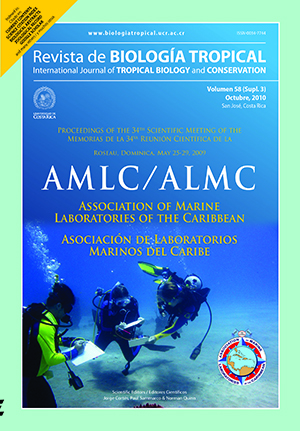Abstract
Seagrass beds are the largest organism-built marine habitat in Dominica, yet have only been surveyed since 2007. Standardized examinations along a depth gradient between 0 and 24m, focusing on magnoliophyte species composition and benthic cover of shoots at 17 seagrass bed sites, were carried out between September 10 and December 7, 2008. The Cymodoceaceae Syringodium filiforme (Kuetzing 1860) and Halodule wrightii (Ascherson 1868), as well as the Hydrocharitaceae Halophila decipiens (Ostenfeld 1902), H. stipulacea (Fosskal & Ascherson 1867) and Thalassia testudinum (Banks ex König 1805) displayed distinct regional and horizontal distribution patterns. Syringodium filiforme is the island’s dominant seagrass along the western and northern coasts, occurring at depths between 2 and 18m and with a mean benthic cover ranging from 0.9-10% along the West coast. Along the North coast it grew between 0.2 and 1m depth with a mean maximum benthic cover of 48.9%. Halodule wrightii grew along the North and West coasts, in depths between 1 and 14m in areas of recent and chronic disturbances. Its delicate morphology and sparse benthic cover (<0.1%) did not constitute seagrass beds. Halophila decipiens grew along the deep, shallow and lateral margins of west coast S. filiforme beds and monospecifically in depths between 3 and 24m. Halophila stipulacea, an invasive species, was widespread along 45km of the West coast and was found in depths between 5 and 24m. Both Halophila species formed extensive beds at depths beyond the survey limit of 24m thus playing a potentially important role in the resettlement of shallow areas after storms. H. decipiens and H. stipulacea are currently the second and third most common seagrasses on the island respectively, despite their absence along the North coast. T. testudinum was confined to North coast’s sheltered reef flats at depths 1m or less with mean a benthic cover ranging from 2 to 76%. It grew monospecifically in the most turbulent and in the calmest locations, yet intermixed with S. filiforme in areas of moderate turbulence. Strong surge along the West coast (October 15-16, 2008), associated with Hurricane Omar, caused uprooting and burial of seagrass beds in varying degrees, in particular along the shallow margins between 2 and 10m depth. This event also demonstrated the dynamic nature of Dominica’s shallow seagrass bed margins and the resistance level of individual beds to storm disturbances##plugins.facebook.comentarios##

This work is licensed under a Creative Commons Attribution 4.0 International License.
Copyright (c) 2010 Revista de Biología Tropical






